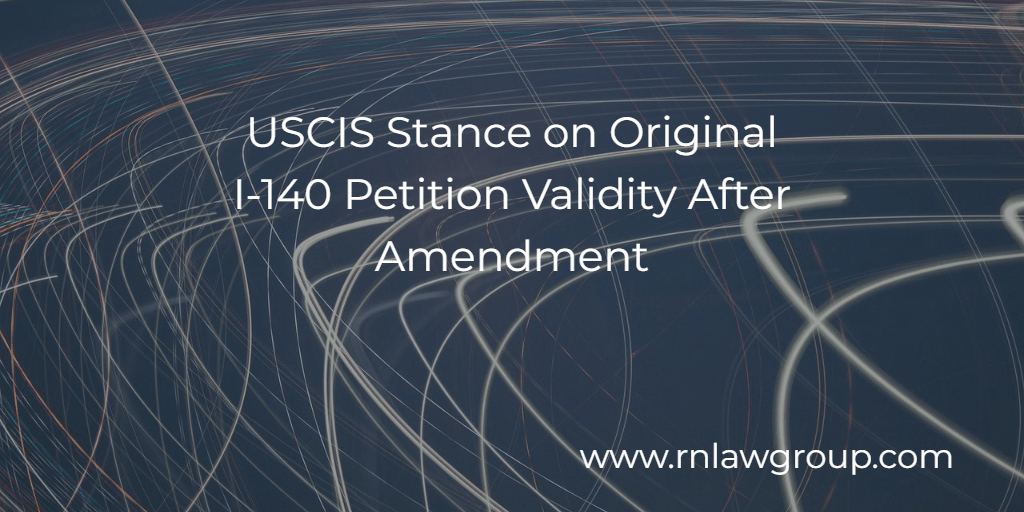
USCIS Stance on Original I-140 Petition Validity After Amendment
The EB-2 to EB-3 downgrade phenomenon that began in October 2020 followed by USCIS encouraging EB-3 applicants to upgrade to EB-2 to utilize available visa numbers has created a number of new issues. One of which is the validity of the original EB-2 I-140 approval in a situation where the EB-3 downgrade I-140 petition was filed as an amendment rather than a new petition.
Reddy Neumann Brown PC had advised petitioners that downgrade petitions should generally be filed as a new petition, not an amendment. An amendment would only be necessary in the situation where a change in corporate structure had occurred and the petitioner is required to establish that it is the successor in interest to the original I-140 petitioner. Some attorneys had been advising employers that a downgrade I-140 petition can only be filed as an amendment. This confusion was based on statements in the USCIS policy manual regarding the use of an expired labor certification:
USCIS continues to accept amended or duplicate petitions that are filed with a copy of a permanent labor certification that is expired at the time the amended or duplicate petition is filed, if the original permanent labor certification was submitted in support of a previously filed petition during the permanent labor certification’s validity period. These filings may occur when:
- There is a successor-in-interest employer change, which requires a new or amended petition;
- The petitioner wishes to file a new petition subsequent to the denial, revocation, or abandonment of the previously filed petition, and the permanent labor certification was not invalidated due to material misrepresentation or fraud relating to the labor certification application;
- The petitioner files an amended petition to request a different immigrant visa classification than the classification requested in the previously filed petition; or
- USCIS or U.S. Department of State (DOS) determines that the previously filed petition has been lost.
Petitioners may not appeal a USCIS decision to deny a petition that is filed with an expired permanent labor certification issued by DOL
Although the statement above suggests that an amended petition is required to request a different immigrant visa classification (such as downgrading from EB-2 to EB-3), prior experience with downgrades has shown that USCIS also accepts new petitions requesting a different immigrant visa classification.
The debate between amendment and new filings would normally not make a difference in the ultimate outcome of the I-140 approval because both accomplish the same goal of providing a new I-140 approval in the new category of EB-3. However, now that USCIS is urging applicants to move to the EB-2 category, the distinction becomes very important. USCIS has recently confirmed that when a Form I-140 is approved as an amendment changing from EB-2 to EB-3, there is no longer an EB-2 petition. There is only an EB-3 petition. By contrast, when a Form I-140 is filed as a “new” petition seeking a change from EB-2 to EB-3 and approved, there is then an approved EB-2 and an approved EB-3 petition. It is the agency’s position that when the underlying I-140 petition was amended from an EB-2 to an EB-3 and the original EB-2 no longer exists, the petitioner cannot transfer the adjustment of status to the original EB-2 but must instead file a new EB-2 petition.
In other words, when the downgrade petition was filed as an amendment, it is not possible for an applicant to interfile the original EB-2 I-140 approval in order to transfer a pending I-485 from the EB-3 category to the EB-2 category. It would also not be possible to file a new I-485 application in the EB-2 category based on the original EB-2 I-140 approval since that approval no longer exists under USCIS’ interpretation. Therefore, in order for a downgrade applicant whose EB-3 I-140 petition was filed as an amendment to change into the EB-2 category, the petitioner must file a new I-140 petition in the EB-2 category, using the same labor certification as the previous two I-140 petitions assuming the job offer remains the same. If the final action date is current in the EB-2 category, once the new I-140 petition is filed in EB-2, a pending I-485 can be transferred to the pending EB-2 I-140 by submitting a new I-485 supplement J along with the new I-140 receipt notice. If a new I-485 is intended to be filed and the priority date is current in EB-2, the new I-140 and I-485 can be filed concurrently.
By: Emily Neumann
Emily Neumann is Managing Partner at Reddy Neumann Brown PC with over 15 years of experience practicing US immigration law providing services to U.S. businesses and multinational corporations. Emily has helped transform the firm from a solo practice to Houston’s largest immigration law firm focused exclusively on U.S. employment-based immigration. She received her Bachelor’s degree in Biology from Central Michigan University and her Juris Doctorate degree from the University of Houston Law Center. Emily is a frequent speaker and has been quoted in Bloomberg Law, U.S. News & World Report, Inside Higher Ed, and The Times of India on various hot topics in immigration. She is a member of the American Immigration Lawyers Association and Society for Human Resource Management.

